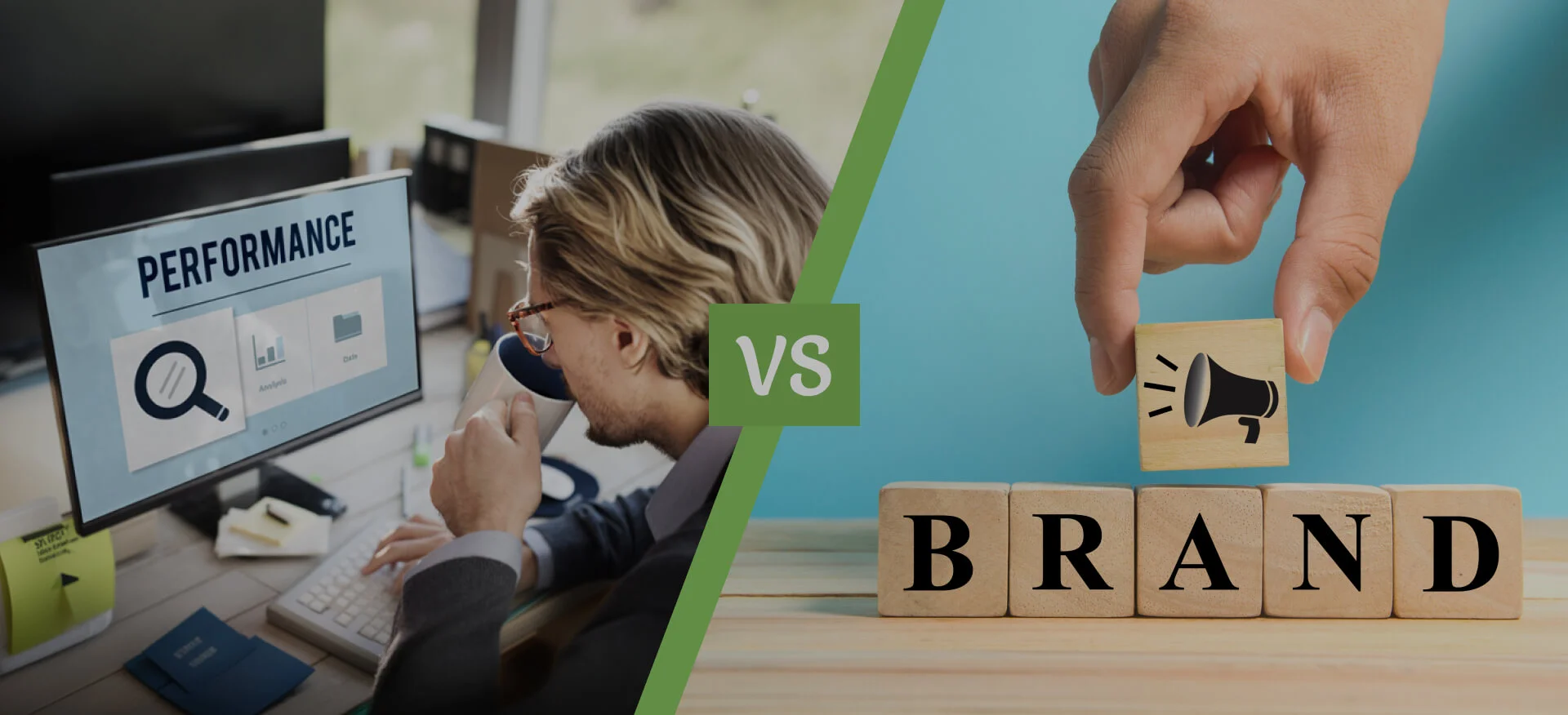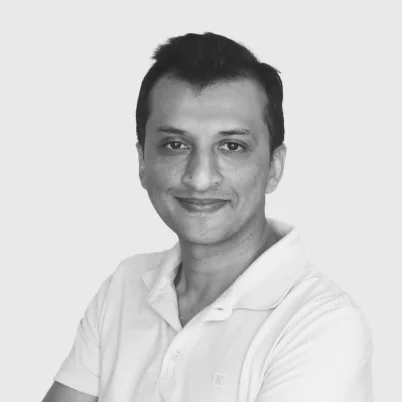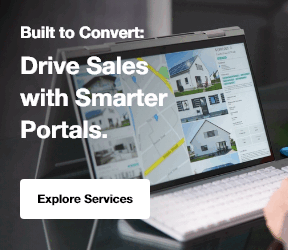Brand marketing vs performance marketing are two essential strategies in modern marketing, each playing a vital role in driving business growth.
While both aim to enhance a company's market presence and profitability, they differ fundamentally in their approaches and objectives.
For example, businesses often rely on growth marketing strategies to integrate long-term brand-building efforts with short-term performance metrics, achieving a balanced approach to growth.
Brand Marketing focuses on building long-term brand equity by fostering emotional connections with consumers, establishing trust, and creating a distinctive brand identity.
This strategy emphasizes storytelling, consistent messaging, and brand positioning to influence consumer perceptions over time.
Performance Marketing, on the other hand, is centered around achieving measurable outcomes such as clicks, leads, conversions, and sales.
It leverages data-driven tactics, real-time analytics, and targeted campaigns to optimize return on investment (ROI) and drive immediate results.
This guide will help you understand the distinctions between these strategies is crucial for businesses aiming to develop a comprehensive marketing plan that balances long-term brand development with short-term performance objectives.
What is Brand Marketing?
Brand marketing is a strategic approach focused on building and promoting a company's identity, values, and emotional connections with its audience. This is essential for businesses that want to develop a digital marketing strategy that tracks users across the web to build a deeper connection with them over time. Unlike product marketing, which emphasizes immediate sales, brand marketing aims to establish long-term recognition, trust, and loyalty.

Unlike product marketing, which emphasizes immediate sales, brand marketing aims to establish long-term recognition, trust, and loyalty.
It involves consistent messaging, storytelling, and visual elements that resonate with consumers on a deeper level.
Some of the key characteristics are mentioned below:
- Long-Term Focus: Brand marketing is a marathon, not a sprint. It prioritizes sustained growth and lasting impressions over short-term gains. This approach helps in cultivating a strong brand presence that endures over time.
- Emotional Connection: Effective brand marketing taps into the emotions of consumers, creating a sense of belonging and trust. By aligning with values and aspirations, brands foster deeper relationships with their audience.
- Trust-Building: Consistency in messaging, quality, and customer experience builds credibility. A trusted brand becomes a go-to choice for consumers, often leading to brand loyalty and advocacy.
The Importance of Brand Marketing
Brand marketing plays a critical role in positioning a brand as a leader within its industry, creating a lasting impression in consumers’ minds. The goal is to build trust, foster loyalty, and establish the brand as an iconic figure in its space. When executed effectively, it can drive long-term consumer relationships, transforming individuals into loyal fans and boosting their lifetime value.
Take brands like Nike and Apple, their success is attributed not only to their products but to their consistent, strategic brand marketing. These brands are often the first choice for consumers because they’ve earned a reputation for quality and innovation. This perception of leadership is what drives consumer preference and turns casual buyers into brand advocates.
In essence, brand marketing is about building brand equity, increasing brand awareness, and cultivating brand loyalty. It focuses on creating emotional connections that encourage consumers to choose the brand repeatedly, even when alternatives are available.
5 Key Brand Marketing Metrics
Brand marketing metrics are different from performance marketing because they measure emotional and long-term brand value rather than short-term transactional success.

Here are five key metrics that can guide the effectiveness of your brand marketing strategy:
- Brand Awareness: Measures how well consumers recognize and recall your brand, both aided (with cues) and unaided (without prompts). High awareness is critical for being the go-to choice in your industry.
- Brand Equity: Represents the value of the brand based on consumer perceptions, associations, and loyalty. Strong brand equity can lead to premium pricing and a competitive advantage.
- Brand Sentiment: Gauges the emotional tone of consumer attitudes towards your brand. Positive sentiment often correlates with greater brand loyalty and advocacy. It’s typically tracked through social media listening tools and consumer surveys.
- Net Promoter Score (NPS): A critical indicator of customer satisfaction and loyalty, NPS measures the likelihood that consumers will recommend your brand to others. A high NPS signals strong brand loyalty.
- Share of Voice (SOV): This metric measures the brand’s visibility compared to its competitors. It tracks the brand’s media presence and advertising efforts, helping to gauge how much attention the brand is commanding in the market.
Top 5 Effective Brand Marketing Strategies
To successfully build long-term brand value, companies must implement a variety of strategic approaches, including What Is Direct Marketing, which focuses on directly reaching target customers.
1. Content Marketing
Content marketing includes Creating valuable, relevant content that speaks directly to your target audience. By offering insights, stories, and educational material, you can position your brand as a trusted authority in your industry, , supported by advertising strategies.
2. Public Relations (PR)
Maintain and shape the public perception of your brand. PR strategies include managing media coverage, issuing press releases, and participating in public events. Positive PR helps maintain your brand's reputation and trustworthiness.
3. Sponsorships and Partnerships
Aligning with influential events, organizations, or complementary brands helps expand your brand’s reach and credibility. Strategic partnerships amplify your presence while aligning with brands or causes that share your values.
4. Influencer Marketing
Partner with influencers who resonate with your target audience. Their endorsement can expand your brand’s reach and lend credibility by associating your brand with trusted voices.
5. Brand Storytelling
Share your brand's unique history, values, and mission in an authentic way. Connecting emotionally with consumers through storytelling fosters loyalty, as people are more likely to support brands they feel personally invested in.
Explore Our Branding Services!
What is Performance Marketing?
Performance marketing is a results-driven digital marketing strategy where advertisers pay only when a specific action, such as a click, lead, or a sales is completed. By utilizing digital marketing services, businesses can optimize their campaigns based on real-time data, ensuring maximum return on investment. Additionally, businesses may choose web design and development services to ensure their websites are optimized for performance marketing goals.
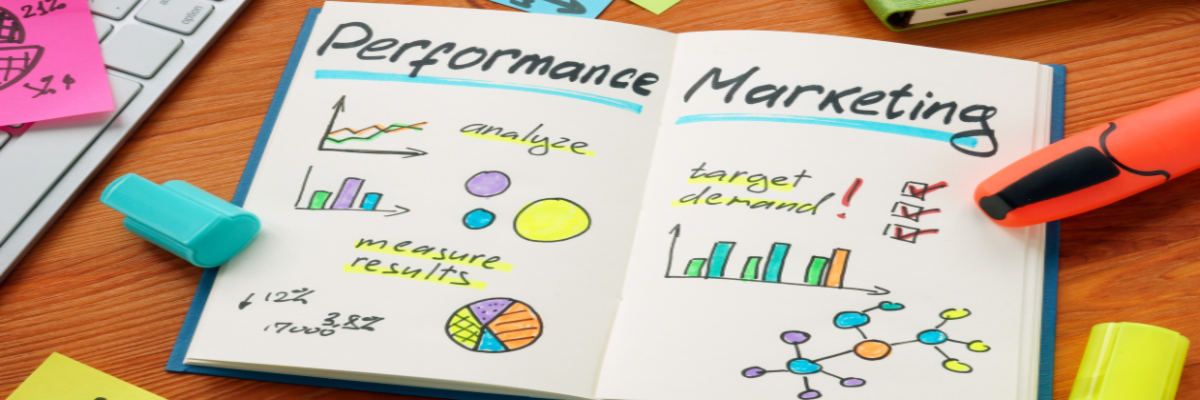
This approach ensures that marketing expenditures are directly tied to measurable outcomes, maximizing return on investment (ROI) and providing clear accountability for every marketing dollar spent.
Some of the key characteristics of performance marketing are as follows:
1. Data-Driven Decision Making
Marketers utilize tools like Google Analytics and heat maps to track user behavior, enabling real-time adjustments and optimization of campaigns.
2. ROI-Focused Metrics
The success of performance marketing is measured through key performance indicators (KPIs) such as cost per click (CPC), cost per acquisition (CPA), return on ad spend (ROAS), and customer lifetime value (CLTV).
3. Short-Term, Action-Oriented Goals
Campaigns are designed to drive conversions promptly, making it ideal for businesses seeking quick results.
The Importance of Performance Marketing
A well-structured performance marketing strategy is crucial because it directly ties measurable outcomes to your advertising spend, offering clear insights into the effectiveness of each dollar spent. In contrast to broader marketing approaches, performance marketing focuses on driving immediate results such as conversions or sales, making it easier to evaluate the impact of your efforts.
In times of economic uncertainty, performance marketing helps companies justify their advertising budgets by demonstrating the immediate return on investment. With clear KPIs, it's straightforward to assess whether a campaign is successful, allowing businesses to optimize their marketing dollars for maximum impact.
5 Key Performance Marketing Metrics
To measure the success of a performance marketing campaign, you need to focus on key metrics that track immediate, tangible outcomes. These metrics are what differentiate performance advertising from other types of marketing strategies.

Here are five essential metrics used in performance marketing:
- Cost Per Acquisition (CPA): The cost incurred to acquire a new customer through your marketing efforts, a critical metric for understanding the efficiency of your campaign.
- Return on Ad Spend (ROAS): This measures the revenue generated for each dollar spent on advertising, offering a clear picture of the effectiveness of your paid media efforts.
- Cost Per Mille (CPM): The cost of reaching 1,000 people, helping marketers assess the cost-efficiency of targeting a broad audience.
- Click-Through Rate (CTR): The ratio of users who click on an ad compared to those who view it, an essential metric for evaluating ad engagement.
- Cost Per Click (CPC): The cost paid for each click on an ad, indicating the efficiency of your paid advertising campaigns.
These metrics make performance advertising more data-driven and measurable, helping advertisers fine-tune their strategies for optimal results.
Top 3 Performance Marketing Strategies
To optimize performance marketing, three primary channels are key for driving measurable outcomes:
1. Search Engine Marketing (SEM)
Running paid ads on search engines targets users actively searching for relevant keywords, generating immediate results through clicks and conversions.
2. Social Media Marketing (SMM)
Using targeted ads on platforms like Facebook and Instagram allows advertisers to reach specific audiences and measure outcomes like engagement, clicks, and conversions.
3. Connected TV (CTV) Advertising
Ads placed on streaming platforms provide precise targeting and measurable outcomes, combining the effectiveness of digital advertising with the broad reach of traditional TV.
Performance marketing allows companies to track, optimize, and measure the success of their advertising campaigns in real-time. This makes it an essential approach for maximizing return on investment and driving results.
Explore Our Performance Marketing Services!
15 Key Differences: Brand Marketing vs Performance Marketing
Brand Marketing focuses on building long-term brand equity through emotional connections and storytelling, while Performance Marketing is centered on achieving immediate, measurable actions like clicks, leads, or sales.
Here’s a detailed comparison of Brand Marketing vs Performance Marketing in table format:
| Aspect | Brand Marketing 🎯 | Performance Marketing 📊 |
|---|---|---|
| Objective | Build long-term brand awareness, trust, and emotional connections. | Achieve immediate, measurable results like clicks, leads, or sales. |
| Focus | Brand positioning, consumer loyalty, and brand equity. | Short-term outcomes such as conversions, traffic, and direct sales. |
| Time Horizon | Long-term (months to years) | Short-term (immediate to a few months) |
| Metrics | Brand awareness, brand equity, brand sentiment, Net Promoter Score (NPS), Share of Voice (SOV). | Clicks, conversions, Return on Investment (ROI), cost per acquisition (CPA), cost per lead (CPL). |
| Goal | Establish a strong brand identity and foster customer loyalty. | Drive immediate actions (e.g., purchases, sign-ups, clicks). |
| Approach | Emotional, qualitative, and focused on storytelling and content. | Data-driven, quantitative, and focused on performance tracking. |
| Channels Used | TV, radio, print media, social media, sponsorships, influencer collaborations, PR campaigns. | Digital ads (PPC, display ads), affiliate marketing, retargeting, email marketing. |
| Budget Allocation | Higher long-term investments with gradual results. | Budget focused on high ROI activities, often with a focus on cost-efficiency. |
| Customer Relationship | Builds long-term relationships with consumers, fostering brand loyalty. | Primarily focused on customer acquisition and immediate sales or leads. |
| Audience | Broad, aiming to reach as many potential customers as possible to create widespread brand recognition. | Targeted, focusing on specific segments or individuals most likely to convert. |
| Creativity | Highly creative, with a focus on emotional connection and brand storytelling. | Focuses on optimizing ad copy, visuals, and offers for conversions. |
| Example | Coca-Cola, Nike, Apple – creating emotional connections with their audience through consistent brand messages. | Amazon, Uber, and other direct-response companies focusing on specific actions like purchases or sign-ups. |
| Measurement of Success | Long-term metrics such as brand recall, sentiment analysis, and market share. | Short-term metrics like CTR (Click-Through Rate), conversion rate, and ROI. |
| Flexibility | Less flexible due to long-term focus and slower changes. | Highly flexible with the ability to quickly adjust tactics based on real-time data. |
| Risk | Higher upfront investment with slower, less measurable results. | More controlled risk due to real-time performance tracking and cost-per-action focus. |
Best 3 Advantages of Brand Marketing
Brand Marketing builds long-term customer trust and loyalty, enhances competitive differentiation, and delivers higher return on investment over time.
Companies with a strong focus on branding services are better positioned to foster these connections and improve customer loyalty, making it easier to engage with both new and returning customers.
1. Builds Trust and Loyalty
A strong brand fosters trust and emotional connections with customers, leading to increased loyalty and repeat business. For instance, 89% of consumers remain loyal to brands they trust .
2. Higher Long-Term ROI
Investing in brand marketing yields sustained returns over time. Companies with strong brand scan charge premium prices and enjoy higher customer lifetime value.
3. Competitive Differentiation
A unique brand identity sets a company apart in a crowded market. Differentiation through branding allows businesses to stand out and build lasting relationships with their target audience.
Best 3 Advantages of Performance Marketing
Performance Marketing offers immediate, measurable results, precise budget control, and scalability, enabling businesses to optimize campaigns for maximum return on investment.
hen businesses look to understand how to measure brand awareness, tools like Shopify or Google Analytics can help track the effectiveness of performance-driven campaigns.
These tools help marketers track KPIs like Google keyword ranking and conversion rates, ensuring that resources are used most effectively.
1. Immediate Measurable Results
Performance marketing operates on a pay-for-performance model, meaning advertisers only pay when a specific action such as a click, lead, or sale is completed.
This approach ensures that every marketing dollar spent is directly tied to tangible outcomes, providing clear accountability and minimizing financial risk
2. Budget Control and Flexibility
One of the standout advantages of performance marketing is its scalability.
Unlike traditional marketing methods that require significant upfront investments, performance marketing allows you to scale your campaigns based on real-time performance data.
If a particular strategy or channel is delivering exceptional results, allocate more resources to maximize effectiveness.
This flexibility ensures that your marketing efforts can grow in tandem with business needs, adapting to changing market conditions and opportunities.
3. Scalable and Easily Testable
Performance marketing thrives on data-driven insights and continuous optimization.
By analyzing key metrics such as click-through rates, conversions, and customer lifetime value, marketers can refine their marketing efforts and make data-driven decisions.
This enables businesses to understand what works and what doesn't, allowing them to adjust their strategies to optimize their marketing spend and maximize their return on investment.
Through ongoing optimization, businesses can achieve greater efficiency and improve their marketing efforts over time.
Explore Our Digital Marketing Services!
Top 3 Challenges in Brand Marketing
Brand marketing often faces challenges in measuring brand awareness and ROI, as long-term results like increased brand recall and trust do not always immediately translate into direct sales.
Despite these challenges, working with a luxury branding agency or a tech marketing agency can help refine brand positioning and improve results through advanced strategies.
Main challenges in brand marketing are as follows:
1. Difficulty in Measuring ROI
Brand marketing often focuses on long-term objectives like awareness and loyalty, which are challenging to quantify.
Traditional metrics such as impressions or brand recall may not directly translate to immediate sales, making it hard to assess the return on investment accurately.
To address this, businesses can implement advanced analytics tools and attribution models that connect brand activities to customer behavior and sales over time.
Utilizing brand lift studies and customer surveys can also provide qualitative data supporting quantitative findings.
2. High Upfront Cost
Building a brand requires significant investment in creative development, media buying, and strategic planning.
These costs can strain budgets, especially for small businesses without immediate financial returns.
Prioritizing cost-effective channels and tactics, such as content marketing and social media engagement, can help build brand presence without overspending.
Focusing on organic growth strategies offers long-term benefits and sustainability.
3. Long-Term Commitment
Brand marketing demands sustained efforts over extended periods to yield results. This long-term commitment can be challenging to maintain, particularly when short-term results are desired.
Setting clear, incremental milestones to track progress and maintain momentum is crucial. Aligning brand initiatives with broader business goals ensures continued support and relevance, fostering a consistent and enduring brand presence.
Top 3 Challenges in Performance Marketing
Main challenges in Performance marketing are as follows:
1. Over-Reliance on Paid Advertising
Excessive dependence on paid channels like Google Ads or Facebook can lead to diminishing returns and increased costs over time.
This approach may neglect the importance of organic growth and brand building. Diversifying marketing efforts by integrating SEO, content marketing, and community engagement can balance paid and organic strategies.
Regularly reviewing and adjusting ad spend optimizes performance and prevents overspending.
2. Short-Term Focus
Performance marketing emphasizes immediate results, which can overshadow long-term brand development.
This short-term focus might hinder the establishment of lasting customer relationships. Incorporating brand-building elements into performance campaigns, such as storytelling and value propositions, fosters long-term customer loyalty.
Aligning short-term actions with long-term brand goals ensures a cohesive and sustainable marketing strategy.
3. Data Overload
The abundance of data in performance marketing can overwhelm teams, leading to analysis paralysis and delayed decision-making. Implementing data management platforms and dashboards streamlines data collection and analysis.
Focusing on key performance indicators (KPIs) that align with business objectives maintains clarity and drives actionable insights.
Regular training and upskilling of teams ensure effective utilization of data for continuous improvement.
Finding the Right Balance: Brand Marketing vs Performance Marketing
Combining brand marketing and performance marketing is essential for achieving sustainable business growth. Some businesses also choose to integrate Centric (digital transformation agency) for seamless digital marketing strategies. By leveraging both approaches, companies can maintain a consistent brand presence while driving immediate sales and performance metrics.
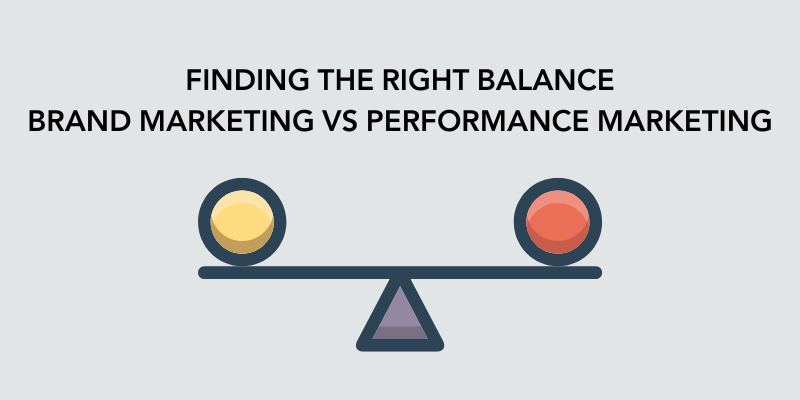
Brand marketing builds long-term trust and emotional connections with audiences, while performance marketing drives immediate, measurable actions like clicks, leads, or sales.
Integrating both strategies ensures a cohesive approach that balances short-term objectives with long-term brand equity.
This synergy enhances customer loyalty, optimizes resource allocation, and maximizes return on investment.
Thus, by aligning brand messaging with performance metrics, businesses can create a unified marketing strategy that resonates with consumers at every stage of their journey.
Conclusion
In conclusion, understanding the difference between brand marketing vs performance marketing is crucial for developing a comprehensive marketing strategy that drives both immediate and long-term results. While brand building vs performance marketing emphasizes creating emotional connections and boosting brand equity over time, performance marketing focuses on generating measurable outcomes such as clicks, leads, or sales through data-driven campaigns.
By integrating performance marketing vs brand marketing, businesses can leverage the strengths of both approaches. Brand performance marketing helps build customer loyalty and strengthens brand perception, while performance advertising drives immediate, actionable results. This balanced approach ensures sustainable growth and adaptability, as demonstrated by successful brands like Intrepid Travel and Koh.
For companies looking to optimize their marketing strategies, working with experts like Centric can help align both performance advertising vs brand advertising with specific business goals. By integrating short-term performance with long-term brand equity, businesses can create a strategy that drives immediate results while securing future brand success.
